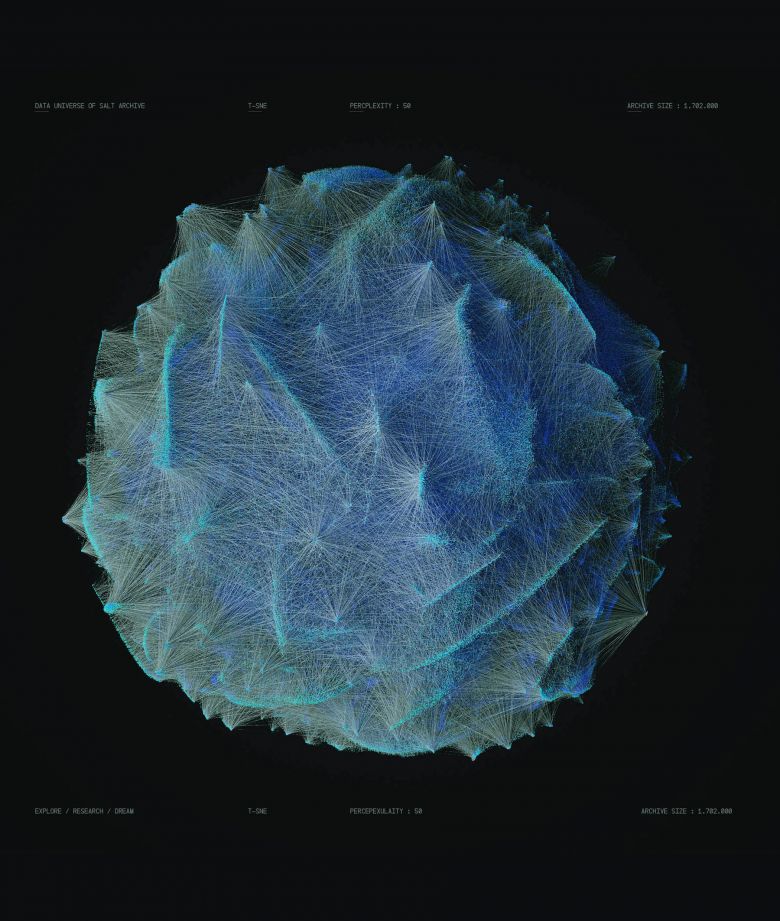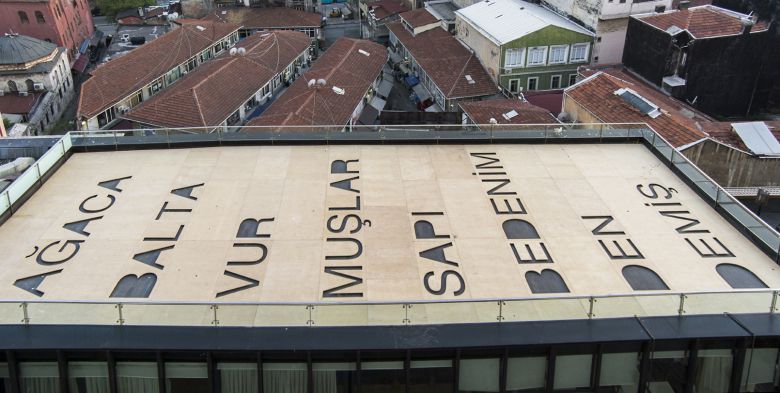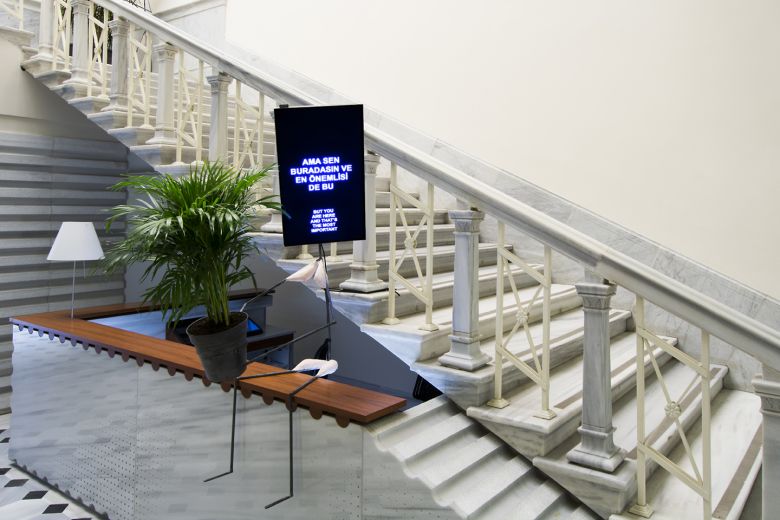The Uses of Art:
Final Exhibition
Salt Galata
April 20 – June 11, 2017

Refik Anadol, image from the SALT Research data process, 2017
Courtesy the artist
Courtesy the artist
What are the implications of urgent conditions, responsibilities, and goals for cultural institutions? These are some of the key issues discussed by those participating in conversations across and beyond the six European museums that make up the L’Internationale confederation.
In April 2017 the five-year L’Internationale program The Uses of Art culminates in a series of simultaneous activities: exhibitions, (online) publications, discursive events, and more. The program offers a wide and prolific reflection on the role of cultural institutions, and aim to encourage broader dialogue between the L’Internationale and partner institutions. Internationalism is not a space of uniformity in politics, industry or culture, and L’Internationale understands that pluriversality can be agonistic.
During The Uses of Art program, SALT produced two major research-based exhibition projects. How did we get here was shown at SALT Beyoğlu and SALT Galata (2015), at SALT Ulus (2016), and as part of The 1980s. Today’s Beginnings? at Van Abbemuseum, Eindhoven, the Netherlands (2016). One and the Many opened at SALT Galata in 2016, and recently took place at Çankaya Municipality Contemporary Arts Center, Ankara. SALT team collaborated on a range of inter-institutional development programs in archives, mediation and access, as well as L’Internationale Online and Glossary of Common Knowledge projects. SALT also sourced single-work presentations from the collections of the partner institutions.
SALT’s final The Uses of Art exhibition attempts to provoke original responses and readings from its users of what SALT Galata, as a cultural entity, is or could be. Four artistic interventions/architectural gestures –by Abbas Akhavan, Refik Anadol, Futurefarmers, and Laure Prouvost– embrace the user through their reinvigoration of previously under-used aspects of the building and its resources, such as the archive, bringing to the foreground suggestions of different potential functions or possibilities that temporarily reframe the institution.
This is the first time that SALT has commissioned all the works in one project. The four independent positions have developed out of shared concerns and questions, in order to make a set of related, yet contrasting responses, creating spaces of dissensus and conversation.
In April 2017 the five-year L’Internationale program The Uses of Art culminates in a series of simultaneous activities: exhibitions, (online) publications, discursive events, and more. The program offers a wide and prolific reflection on the role of cultural institutions, and aim to encourage broader dialogue between the L’Internationale and partner institutions. Internationalism is not a space of uniformity in politics, industry or culture, and L’Internationale understands that pluriversality can be agonistic.
During The Uses of Art program, SALT produced two major research-based exhibition projects. How did we get here was shown at SALT Beyoğlu and SALT Galata (2015), at SALT Ulus (2016), and as part of The 1980s. Today’s Beginnings? at Van Abbemuseum, Eindhoven, the Netherlands (2016). One and the Many opened at SALT Galata in 2016, and recently took place at Çankaya Municipality Contemporary Arts Center, Ankara. SALT team collaborated on a range of inter-institutional development programs in archives, mediation and access, as well as L’Internationale Online and Glossary of Common Knowledge projects. SALT also sourced single-work presentations from the collections of the partner institutions.
SALT’s final The Uses of Art exhibition attempts to provoke original responses and readings from its users of what SALT Galata, as a cultural entity, is or could be. Four artistic interventions/architectural gestures –by Abbas Akhavan, Refik Anadol, Futurefarmers, and Laure Prouvost– embrace the user through their reinvigoration of previously under-used aspects of the building and its resources, such as the archive, bringing to the foreground suggestions of different potential functions or possibilities that temporarily reframe the institution.
This is the first time that SALT has commissioned all the works in one project. The four independent positions have developed out of shared concerns and questions, in order to make a set of related, yet contrasting responses, creating spaces of dissensus and conversation.

Abbas Akhavan, "they hit a tree with an axe," 2017
The Uses of Art: Final Exhibition, SALT Galata, 2017
Photo: Mustafa Hazneci
The Uses of Art: Final Exhibition, SALT Galata, 2017
Photo: Mustafa Hazneci
“they hit a tree with an axe”
April 27 - June 11
Abbas Akhavan’s site-specific works often respond to the natural and built environment, reflecting upon the fragility of life, as well as the structures of life that we dwell within. For this exhibition, Akhavan has produced three new site-specific interventions that coexist with the architecture and rhythms of the building and respond to current sociopolitical realities. Installed on the roof terrace of SALT Galata, “they hit a tree with an axe” intercepts the view to and from heritage via the contemporary. This piece is part of an ongoing series where text written on rooftops acts as a poetic gesture, but also as a kind of SOS call presented for aerial viewing by helicopters and airplanes.
The local reference to destruction of “they hit a tree with an axe” is complemented by a 91.44-meter-long, folded white fabric that hangs in the atrium. Similar to a shroud or a white cover for an anticipated reveal, the sheet is a kind of placeholder for the Pearl Monument, a previously insignificant sculpture in Bahrain that gained notoriety when it was torn down by government forces in reaction to public demonstrations that took place in 2011. Accompanying these works, an oversized janitor’s broom with wooden grip leans against the wall between the first and second floors.
Archive Dreaming
April 20 - June 11
What does it mean to hold the archival collections of SALT Research and in particular the content of the Ottoman Bank Museum in a fixed condition? What if these elements could be visualized through machine learning algorithms and artificial intelligence-driven processing power inaccessible only a few years ago, and high-dimensional data brought into interreactions and translated into immersive spaces?
Refik Anadol has been commissioned to work with the massive holdings at SALT Research and the Ottoman Bank Archives to create an immersive interface as well as a user navigated VR experience that challenges our very perception of the notion of a museum and a collection. His media installation on floor -1 transforms the gallery space into an all-encompassing environment that intertwines history with the contemporary.
![4 Futurefarmers Futurefarmers, <i>Seed Journey</i> [Tohum Yolculuğu], 2016
Sanatçıların izniyle](/directus/media/thumbnails/4_futurefarmers-jpg-780-5000-false.jpg)
Futurefarmers, Seed Journey, 2016
Courtesy the artists
Courtesy the artists
Seed Journey
April 27 - ongoing
“Imagine a fantastic voyage from Norway to Istanbul in an old wooden sailing boat built for arctic voyaging. This boat is carrying an ingeniously crafted mini-boat like a chalice containing a mere handful of old wheat and rye seeds found in a museum in St. Petersburg in Russia and in the roof beams of a sauna in northern Norway. They are like jewels these seeds… Surreal to a fault, this voyage is at once mythical, scientific, and political. It is a voyage back through time and space to the origins of these seeds in what is eastern Turkey.”
This is an extract from the opening words of Michael Taussig’s description of Seed Journey, a project by Futurefarmers that launched from Norway in 2016, and will conclude in Istanbul in September 2017. In advance of the boat’s arrival, the artist crew including Amy Franceschini, Alfonso Borragan, Martin Lundberg, Marthe Van Dessel, Audrey Snyder and Ignacio Chapela among others have begun to narrate aspects of the crew’s research and combined knowledge through an installation of sourced and produced materials to be housed in the treasury found inside SALT Research. The contents will adapt and accumulate over the next months as the Seed Journey continues its route to Istanbul. The treasury also hosts a series of collaborative responses from Slow Food Istanbul and Murat Demirtaş.

Laure Prouvost, softer and rounder so as to shine through your smooth marble, 2017
The Uses of Art: Final Exhibition, SALT Galata, 2017
Photo: Mustafa Hazneci
The Uses of Art: Final Exhibition, SALT Galata, 2017
Photo: Mustafa Hazneci
softer and rounder so as to shine through your smooth marble
April 27 - June 11
Can a building respond to its users, present its own fictions and layers of history? Laure Prouvost’s interventions around SALT Galata integrate aspects of earlier works along with site-specific reflections on the spaces and uses of the building. She brings to the surface activities that remain hidden, through intended miscommunications, cultural slippages and storytelling.
Prouvost’s mop women remind us of ongoing behind-the- scenes work such as cleaning and maintenance, yet here they provocatively greet those entering the building with surreal humor and wordplay. Their welcoming phrases launch a series of playful interruptions to the flow of the marble and glass of the ground and first floors. Via techniques of trompe l’œil, the artist plays with some of the most visible architectural components of the building, feminizing the repetitive rhythms of the marble and sending the valiant Parthenon riders off in yet another direction.
This exhibition is part of the five-year program The Uses of Art - The Legacy of 1848 and 1989, organized by L’Internationale.



